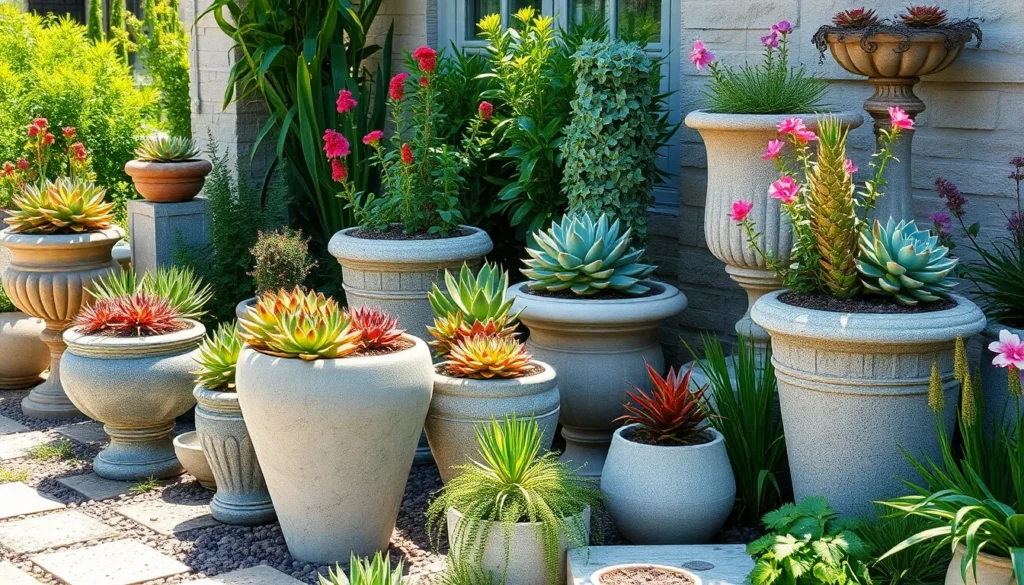Stone pots transform ordinary gardens into stunning outdoor sanctuaries. We’ve discovered that these timeless planters offer the perfect blend of durability and natural beauty that synthetic alternatives simply can’t match. Whether you’re cultivating herbs on your windowsill or creating dramatic focal points in your industry stone containers elevate every planting project.
Why choose stone over plastic or ceramic? We’ll show you how these heavyweight champions withstand harsh weather conditions while developing gorgeous patinas that only improve with age. From limestone to granite each stone type brings unique characteristics that complement different plant varieties and garden styles.
Our comprehensive guide reveals everything you need to know about selecting caring for and styling stone planters. We’ll explore drainage techniques weight considerations and the best plants that thrive in stone environments. Get ready to discover why professional landscapers and home gardeners alike swear by these natural masterpieces.
Benefits of Using Stone Pots for Plants
Stone pots deliver remarkable advantages that transform how we approach container gardening. We’ve discovered these natural vessels offer practical benefits that synthetic materials simply can’t match.
Superior Drainage Properties
Porosity creates optimal water management through stone’s natural structure. We observe how limestone and sandstone allow excess moisture to evaporate gradually while preventing waterlogged soil conditions. Granite varieties provide controlled drainage that protects delicate root systems from rot.
Natural mineral content enhances soil composition over time. Salt deposits and trace elements slowly leach from stone surfaces, enriching the growing medium with beneficial nutrients. Terra cotta and ceramic alternatives lack this mineral supplementation feature.
Multiple drainage channels form naturally in stone construction. Microscopic gaps between stone particles create pathways for air circulation and water movement. We notice plants develop stronger root systems when grown in properly draining stone containers.
Natural Temperature Regulation
Thermal mass properties stabilize soil temperatures throughout daily cycles. Stone absorbs heat during warm periods and releases it gradually as temperatures drop. We measure up to 5°F less temperature fluctuation in stone pots compared to plastic containers.
Insulation qualities protect roots from extreme weather conditions. Thick stone walls shield plant roots from freezing temperatures in winter and excessive heat in summer. We document improved plant survival rates during harsh seasonal transitions.
Evaporation cooling occurs naturally through stone’s porous surface. Water evaporating from stone walls creates a microclimate that reduces stress on plant foliage. We observe this cooling effect extending 2-3 inches beyond the pot’s perimeter.
Exceptional Durability and Longevity
Weather resistance ensures decades of reliable use in outdoor environments. Natural stone withstands freeze-thaw cycles, UV exposure, and acid rain without deteriorating. We track stone planters lasting 20-30 years with minimal maintenance requirements.
Impact resistance protects against accidental damage and wear. Dense stone construction resists chipping, cracking, and breakage that commonly affects ceramic or plastic alternatives. We document significantly lower replacement costs for stone container gardens.
Patina development enhances aesthetic appeal over time. Weathering creates attractive color variations and surface textures that improve with age. We notice how stone pots become more beautiful as they mature in garden settings.
Enhanced Root Development
Stable growing environment promotes robust root system establishment. Stone containers don’t expand or contract with temperature changes like plastic alternatives. We observe more extensive root networks in plants grown in stable stone environments.
pH buffering capacity maintains optimal soil chemistry for plant health. Limestone naturally raises pH in acidic soils while granite provides neutral growing conditions. We measure more consistent nutrient uptake in stone container plantings.
Beneficial bacterial colonies thrive on stone surfaces and support plant health. Porous stone provides habitat for mycorrhizal fungi and other beneficial microorganisms. We document improved plant vigor when these symbiotic relationships develop in stone planters.
Types of Stone Materials for Plant Containers
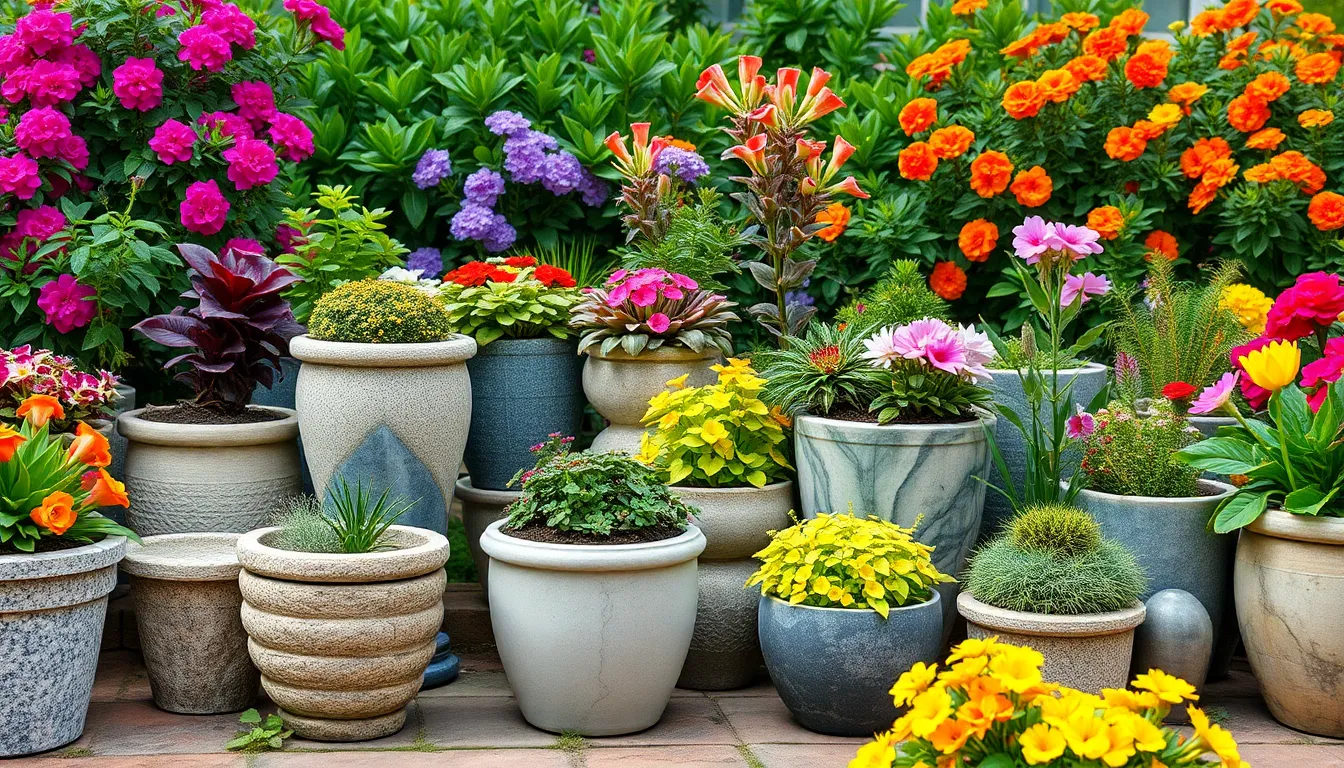
Choosing the right stone material for your planters depends on your exact gardening needs and aesthetic preferences. Each stone type offers unique characteristics that can enhance your plants’ health and your garden’s visual appeal.
Natural Granite Planters
Granite planters deliver unmatched durability and stability for serious gardeners. This dense, hard natural stone provides excellent resistance to weather extremes and maintains its appearance for decades. The weight of granite makes these containers exceptionally stable, preventing tipping even in strong winds or when supporting tall plants.
Temperature regulation becomes effortless with granite’s natural insulating properties. Your plants’ roots stay protected from heat stress during summer and frost damage in winter. The polished surface of granite planters enhances both outdoor patios and indoor spaces with a refined, professional appearance.
Installation requires careful planning due to granite’s substantial weight. Large granite planters often need specialist equipment for positioning, but this initial effort pays off with long term stability and minimal maintenance requirements.
Sandstone Garden Pots
Sandstone containers excel at promoting healthy root development through superior air and moisture exchange. The porous texture of this natural stone allows proper soil aeration while regulating moisture levels to prevent waterlogging and root rot. Plants thrive in sandstone pots because the material creates an ideal growing environment.
Visual appeal comes naturally with sandstone’s warm earthy colors and unique textural variations. Each pot displays distinctive patterns and hues that complement both traditional and contemporary garden designs. The natural beauty of sandstone enhances plant displays without overwhelming the foliage.
Moisture management happens automatically as sandstone absorbs excess water during heavy rains and slowly releases it during dry periods. This natural regulation system helps your plants survive both drought conditions and periods of excessive rainfall. But, sandstone requires more careful handling than harder stones due to its relatively fragile nature.
Limestone Plant Vessels
Limestone vessels provide excellent insulation while offering soft, muted tones that complement any garden palette. These containers protect plant roots from temperature fluctuations throughout the seasons. The natural beauty of limestone creates an elegant backdrop for colorful flowers and lush foliage.
Carving flexibility makes limestone ideal for decorative shapes and custom designs. The softer nature of this stone compared to granite allows for more intricate detailing and personalized touches. Weather resistance ensures your limestone planters maintain their appearance with minimal maintenance over many years.
Durability balances perfectly with limestone’s aesthetic appeal, though some erosion may occur over very long periods in harsh conditions. Regular cleaning keeps limestone containers looking fresh and new. The natural patina that develops over time adds character and depth to your garden displays.
Slate Container Options
Slate planters combine elegant sophistication with practical plant growing benefits. This fine grained metamorphic rock features a smooth texture and distinctive layered structure that creates stunning visual interest. The darker colors of slate containers make plant foliage appear more vibrant and dramatic.
Moisture retention and temperature regulation work together seamlessly in slate vessels. Plants benefit from the stable growing conditions these containers provide. The natural insulating properties protect roots while the smooth surface resists weather damage and maintains its appearance year after year.
Modern garden designs benefit greatly from slate’s clean lines and minimalist aesthetic. These containers suit contemporary landscapes while providing all the practical advantages of stone planters. Slate’s durability ensures your investment will enhance your garden for many seasons to come.
Choosing the Right Size Stone Pot for Your Plants
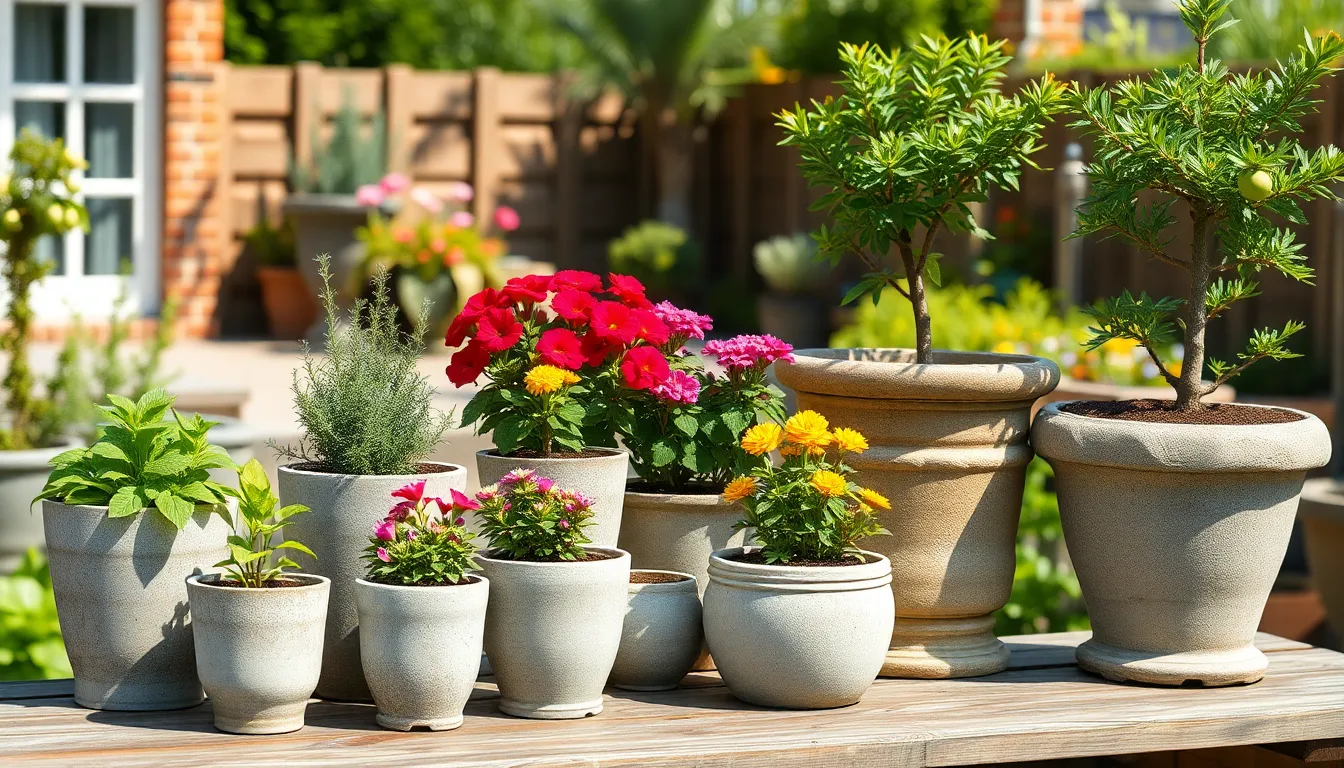
Selecting the appropriate stone pot size directly impacts your plants’ health and growth potential. We’ll guide you through matching container dimensions to exact plant requirements for optimal gardening success.
Small Stone Pots for Herbs and Succulents
Small stone pots excel for herbs and succulents because these plants thrive with compact root systems requiring minimal soil volume. Stone’s natural insulation maintains consistent soil moisture and temperature levels, supporting steady growth without demanding frequent watering schedules.
Basil, thyme, and rosemary flourish in small stone containers ranging from 6 to 10 inches in diameter. Succulents like echeveria, jade plants, and aloe varieties benefit from stone’s moisture regulation properties that prevent root rot while providing adequate drainage.
Kitchen herb gardens become more manageable when we use small stone pots arranged on windowsills or countertops. Stone containers retain heat during cooler months, extending growing seasons for tender herbs that struggle with temperature fluctuations.
Medium-Sized Containers for Flowering Plants
Medium stone pots accommodate flowering plants that demand expanded root space and enhanced nutrient access for vibrant blooms. Their substantial weight provides necessary stability while stone’s insulating qualities regulate soil temperatures, promoting healthier flower development throughout growing seasons.
Geraniums, petunias, and marigolds thrive in medium stone planters measuring 12 to 18 inches across. Stone’s durability ensures these containers withstand outdoor conditions without cracking, warping, or deteriorating under weather stress.
Perennial flowering plants particularly benefit from stone’s temperature buffering effects during seasonal transitions. We’ve observed that stone containers protect root systems from rapid temperature changes that can shock sensitive flowering varieties.
Large Stone Planters for Trees and Shrubs
Large stone planters perfectly suit trees and shrubs requiring extensive root expansion space and superior structural support. Their considerable weight offers unmatched stability against strong winds and severe weather conditions that can topple lighter container materials.
Dwarf fruit trees, ornamental shrubs, and small evergreens flourish in large stone planters exceeding 20 inches in diameter. Stone’s insulating properties protect root systems from temperature extremes, reducing heat stress during summer months and preventing frost damage in winter.
Stone containers can absorb moisture gradually and release it over time, supporting plants through diverse climate conditions without constant irrigation monitoring. We recommend large stone planters for permanent industry features where stability and longevity matter most for successful plant establishment.
Best Plants to Grow in Stone Pots
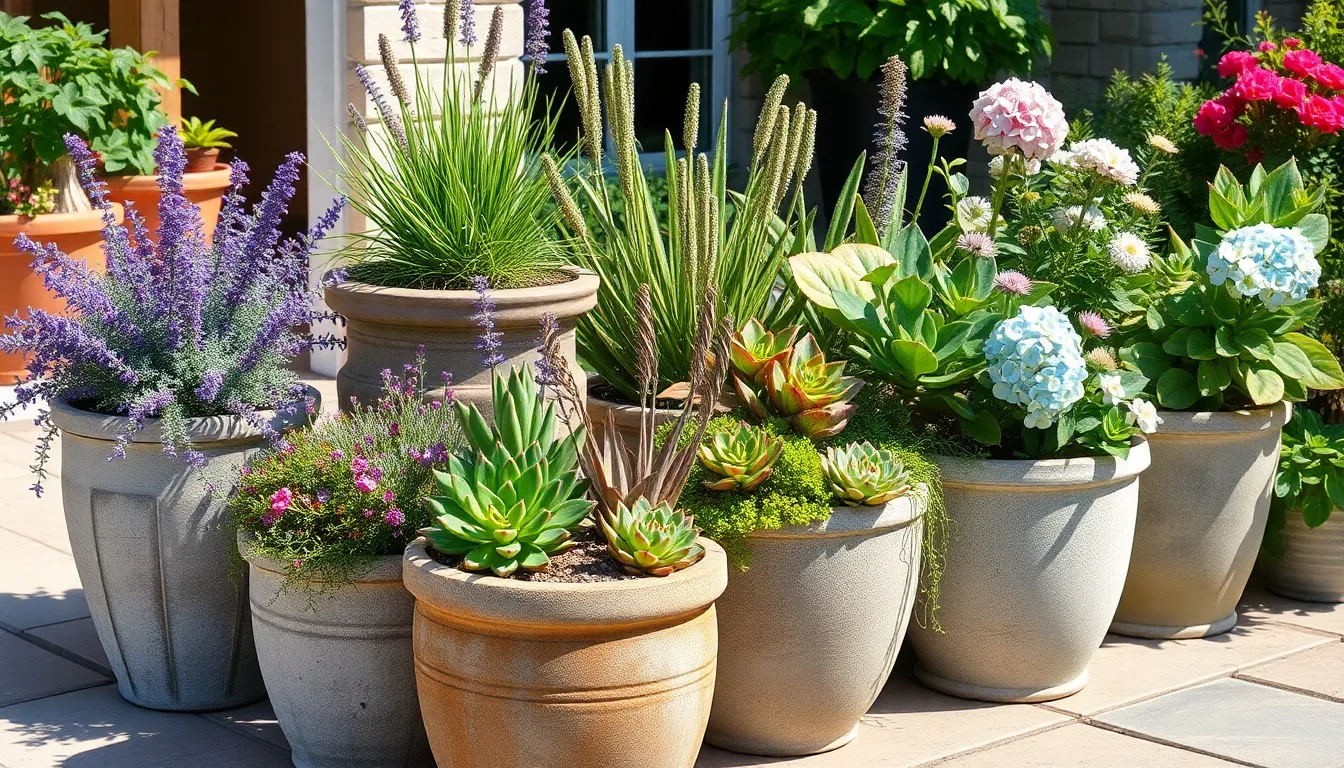
Stone pots create ideal growing conditions for exact plant varieties that thrive in well-drained environments with stable root temperatures.
Drought-Tolerant Succulents and Cacti
Succulents flourish in stone containers because these planters provide excellent drainage and retain minimal moisture, preventing the root rot that often plagues these water-sensitive plants. Century Plant (Agave americana) develops its striking architectural form beautifully in stone pots, where the natural porosity prevents waterlogged conditions. Canary Aeonium (Aeonium canariense) creates stunning rosette displays when planted in stone containers that offer the low-maintenance growing environment these plants require.
Stone pots naturally complement the drought-tolerant nature of cacti, which prefer infrequent watering and well-draining soil conditions. We find that the thermal properties of stone help regulate soil temperature, protecting sensitive cactus roots from extreme heat while maintaining the dry conditions these desert plants need to thrive.
Mediterranean Herbs and Aromatics
Mediterranean herbs achieve their most potent flavors when grown in stone pots that replicate the rocky, well-drained soils of their native regions. Lavender develops its characteristic fragrance and compact growth habit in stone containers that provide the stable root environment this aromatic herb requires. Rosemary thrives in stone planters where the excellent drainage prevents the wet feet that can damage this woody herb.
Thyme and oregano establish robust root systems in stone pots that maintain consistent moisture levels without becoming waterlogged. Stone containers help these aromatic herbs develop their essential oils more intensely, creating more flavorful harvests for culinary use. We’ve found that the natural mineral content of stone gradually enriches the soil, supporting the healthy growth of these Mediterranean favorites.
Perennial Flowers and Ornamentals
Compact hydrangeas like ‘Miss Saori’ and ‘Early Blue’ produce abundant blooms when planted in appropriately sized stone containers that provide adequate drainage and soil conditions. Stone pots offer the root insulation these flowering shrubs need to maintain consistent moisture levels without becoming waterlogged. Patio roses develop strong root systems in stone planters that protect against temperature fluctuations while supporting vigorous flowering.
Azaleas thrive in stone containers when planted with ericaceous compost that maintains the acidic soil conditions these acid-loving plants require. We recommend using stone pots large enough to accommodate the root systems of these ornamental plants while providing the drainage necessary for healthy growth. Stone planters help perennial flowers establish long-term root systems that support years of beautiful blooms.
Small Trees and Topiary Plants
Small conifers develop stable root systems in stone containers that provide the weight and stability these upright plants need to resist wind damage. Cordyline australis (cabbage palm) creates striking focal points when planted in stone pots that offer protection against temperature extremes while supporting the plant’s tropical growth requirements. Hosta varieties thrive in stone planters where the thermal properties help regulate soil temperature and protect roots from heat stress.
Stone containers accommodate the root systems of small ornamental trees while providing the insulation necessary for year-round outdoor growing. We’ve observed that topiary plants maintain their sculpted forms better when grown in stone pots that offer consistent growing conditions. The durability of stone planters makes them ideal for long-term plantings of trees and topiary specimens that require stable growing environments for decades of healthy development.
Proper Care and Maintenance of Stone Plant Containers
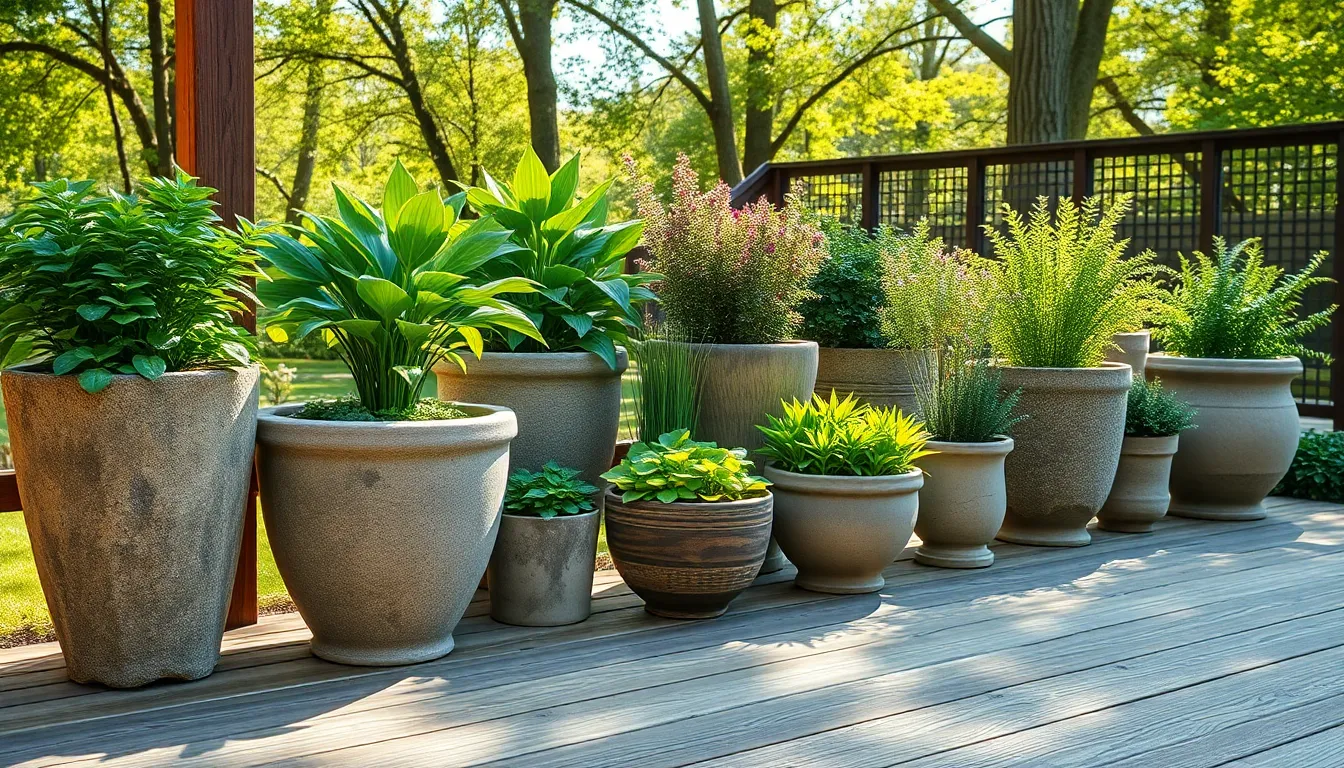
Stone planters require exact maintenance practices to preserve their natural beauty and functionality over time. We’ll guide you through essential care techniques that protect your investment and keep your containers looking pristine.
Regular Cleaning Techniques
Clean your stone pots regularly using mild soap and water with a soft microfiber cloth. Gentle circular motions help remove dirt and debris without scratching the stone’s surface. Spot cleaning with a damp cloth works effectively for minor soil buildup between thorough cleanings.
Avoid harsh chemicals and high-pressure water sprays that can erode the stone surface over time. Use soft cloths or natural sponges rather than abrasive scrubbers to preserve the container’s original texture and color. Regular maintenance prevents stubborn stains from setting into porous stone materials.
Preventing Mineral Buildup and Staining
Rinse your stone pots periodically to wash away accumulated salts from water and fertilizers. Porous stone types like sandstone and limestone are particularly susceptible to mineral deposits that can create unsightly white stains.
Use filtered or rainwater instead of hard tap water to reduce mineral accumulation on your containers. Soak affected pots in a vinegar-water solution occasionally to dissolve stubborn mineral stains, followed by thorough rinsing with clean water. This natural cleaning method safely removes buildup without damaging the stone.
Seasonal Protection Methods
Move stone pots indoors or into sheltered areas during freezing temperatures to prevent freeze-thaw damage. Stone containers can crack when water inside expands and contracts with temperature changes. Cover outdoor planters with breathable frost cloths or biodegradable fleece during harsh winter conditions.
Avoid leaving pots sitting in waterlogged soil or standing water, especially during wet seasons. Elevate containers slightly using pot feet or bricks to improve air circulation and prevent moisture damage. These protective measures significantly extend the lifespan of your stone planters.
Drainage Hole Maintenance
Ensure drainage holes remain clear by regularly removing debris and soil buildup that can block water flow. Place a layer of small stones or broken pottery shards at the bottom of pots before adding soil to improve drainage efficiency.
Inspect drainage holes monthly and clean them with a thin stick or wire if blocked. Proper drainage prevents waterlogging and root rot while maintaining the health of your plants. Well-maintained drainage systems are essential for the long-term success of container gardening in stone pots.
Where to Place Stone Pots for Optimal Plant Growth
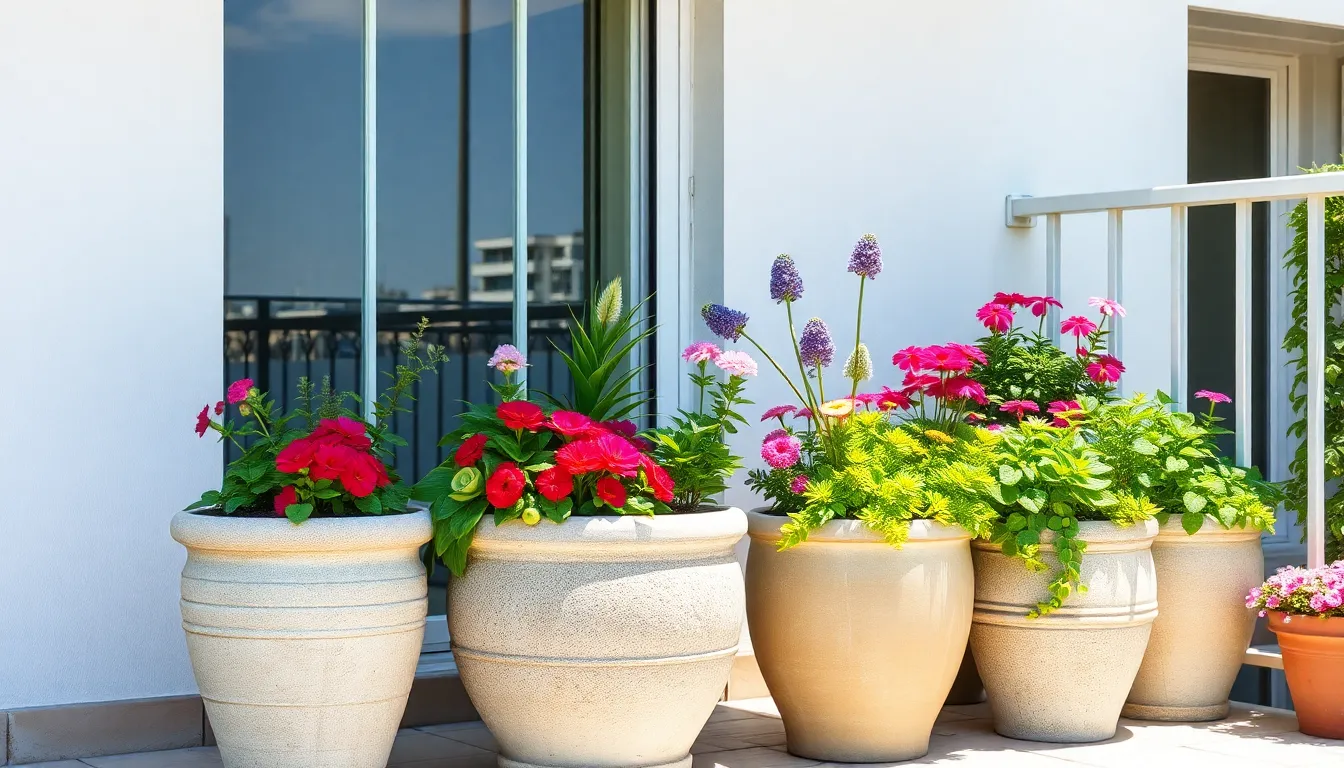
Strategic placement of stone pots maximizes both plant health and visual appeal. Location determines whether your plants thrive or struggle in their stone containers.
Indoor Positioning Considerations
Positioning stone pots near natural light sources ensures your plants receive adequate sunlight for photosynthesis. Windows provide the most consistent indoor illumination, making them ideal spots for stone container gardens.
Grouping pots with similar water and light requirements simplifies your care routine while preventing plant stress. Succulents and cacti work well together, while tropical plants share different needs.
Layering arrangements in tall stone pots creates stunning vertical displays that optimize space. We recommend placing taller plants at the bottom and shorter ones on top in pyramid formations for maximum visual impact.
Large stone planters at entrances or focal points enhance your home’s decor while welcoming guests. These statement pieces draw attention and create conversation starters in living rooms, hallways, or entryways.
Outdoor Placement Strategies
Positioning stone pots near pathways and doorways creates visual interest while defining outdoor spaces. A strategically placed pot at the end of a garden path guides visitors’ eyes and signals direction changes.
Lining driveways or walkways with stone planters draws attention to your industry while softening harsh hardscaping elements. This technique creates continuity between different garden areas.
Arranging planters in odd numbers with varied heights produces natural, pleasing compositions. Groups of three or five containers create visual balance without appearing overly structured.
Choosing locations near water sources simplifies maintenance tasks and reduces plant stress. Proximity to irrigation systems or outdoor faucets ensures consistent watering schedules.
Matching plant types to environmental conditions optimizes growth potential in stone containers. Drought tolerant varieties thrive in sunny locations, while moisture loving plants prefer shaded spots.
Balcony and Patio Arrangements
Using tall stone pots as statement pieces transforms balconies and patios into stylish outdoor rooms. Positioning these containers by entrances or seating areas creates welcoming atmospheres for entertaining.
Mixing plants with similar care requirements in single stone pots prevents complications and promotes healthy growth. Combining compatible species reduces maintenance while maximizing visual impact.
Incorporating thrillers, fillers, and spillers creates layered displays that add depth to small spaces. Eye catching centerpiece plants, supporting foliage, and cascading varieties produce professional looking arrangements.
Garden Integration Ideas
Integrating stone pots within existing gardens creates focal points without disrupting natural landscapes. Grouping containers with similar plant types or colors maintains design coherence.
Using stone pots to complement hardscaping softens concrete areas while adding organic elements. These containers bridge the gap between structural features and living plants.
Placing pots at garden corners and along retaining walls highlights exact areas without overwhelming the space. Strategic positioning near mailboxes or entry points creates welcoming first impressions.
Accounting for mature plant size prevents overcrowding and ensures proper development. Planning for full grown dimensions allows adequate space for root expansion and canopy spread.
Cost Considerations When Buying Stone Pots for Plants
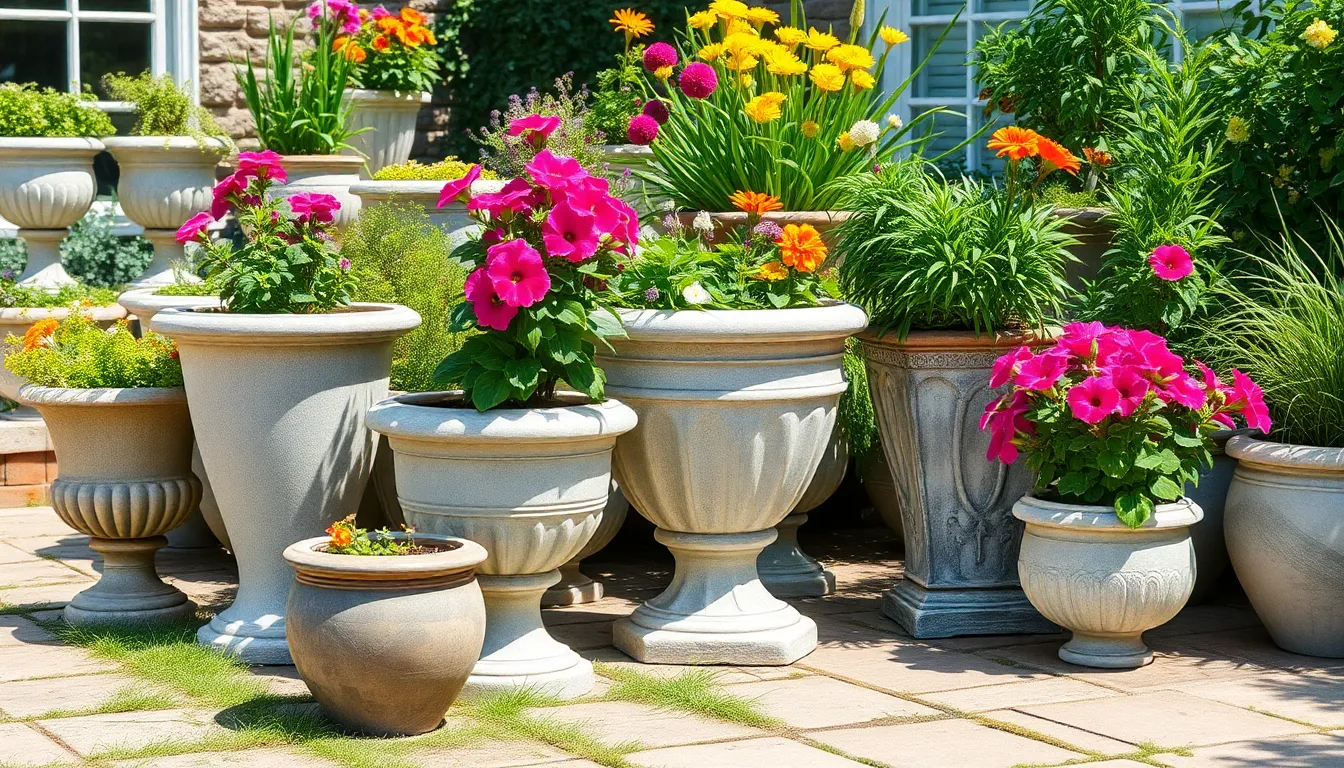
Smart stone pot shopping starts with understanding your budget and long-term needs. We’ll break down the pricing tiers to help you make the best investment for your garden.
Budget-Friendly Options
Entry-level stone pots typically feature faux stone varieties made from fiberglass or fiberstone composites that deliver natural aesthetics without very costly. Starting around $87.77 at retailers like Bed Bath & Beyond, these lightweight alternatives provide decent durability and appealing textures. Composite materials simulate authentic stone appearance while keeping costs manageable for budget-conscious gardeners.
Fiberglass stone pots offer excellent value by combining affordability with weather resistance and easy handling. These synthetic options won’t crack like real stone and require minimal maintenance throughout their lifespan. Budget shoppers can find quality faux stone containers that look remarkably similar to expensive natural materials.
Mid-Range Quality Choices
Fiberstone planters represent the sweet spot between affordability and quality, blending fiberglass with stone dust for authentic texture and appearance. These composite containers cost more than pure fiberglass due to their superior stone-like finish and enhanced durability. Prices typically range from $135 to $315 at major retailers like Lowe’s and Home Depot, depending on size and design complexity.
Mid-range stone pots offer excellent balance between weight, durability, and premium finishes that satisfy most gardening needs. These containers provide authentic stone aesthetics while remaining accessible to average homeowners. Quality fiberstone options deliver long-lasting performance without the extreme weight or cost of genuine stone materials.
Premium Stone Container Investments
High-end stone pots feature genuine cast stone or natural stone construction that offers superior durability, weather resistance, and timeless beauty. These authentic materials can last for decades with proper care, making them worthwhile investments for serious gardeners. Examples include 24-inch square cast stone fiberglass planters costing upwards of $315 for premium quality and craftsmanship.
Real stone containers provide maximum longevity and classic elegance that synthetic alternatives can’t match completely. These heavy, expensive options resist environmental damage better than any composite material. Premium stone pots become permanent garden features that add important value to outdoor spaces.
Value vs. Longevity Analysis
Faux stone containers deliver exceptional durability for their price point while remaining less prone to cracking or breaking compared to genuine stone. Though initial costs exceed cheap plastic alternatives, their extended lifespan creates excellent cost effectiveness over time. Budget-friendly composite materials often outlast more expensive options when considering maintenance and replacement needs.
Investment decisions should weigh upfront budget against expected lifespan, maintenance requirements, and aesthetic preferences for optimal value. Real stone pots justify higher costs through decades of reliable performance and classic beauty that never goes out of style. Choosing between price tiers depends on balancing immediate budget constraints with long-term garden goals and visual expectations.
Common Mistakes to Avoid with Stone Plant Containers
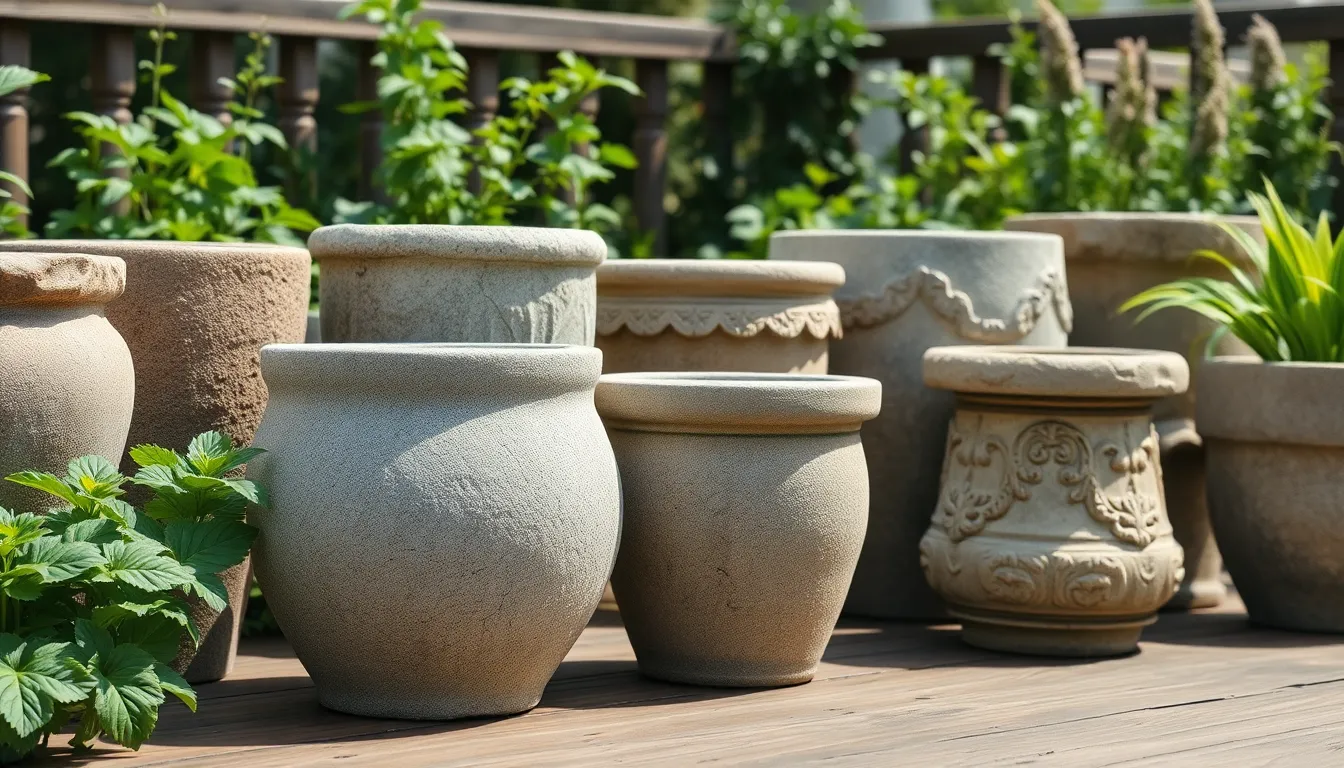
Stone planters require different care approaches than synthetic containers, and understanding these differences prevents costly plant losses and container damage.
Overwatering Issues
Stone pots naturally absorb moisture through their porous surfaces, creating unique watering challenges that many gardeners overlook. We often see gardeners apply the same watering schedule they’d use for plastic or ceramic containers, not realizing that stone’s moisture retention properties change soil hydration dynamics completely.
Overwatering becomes particularly problematic because stone absorbs water and releases it slowly back into the soil. This extended moisture exposure can cause soil to remain waterlogged for days longer than expected, leading to root rot in plants that aren’t adapted to consistently wet conditions. Stone containers also suffer structural damage when oversaturated, as absorbed water can cause expansion and eventual cracking during temperature fluctuations.
Monitor soil moisture levels by checking deeper than surface appearance suggests, since stone’s porosity means surface dryness doesn’t indicate actual soil conditions. Adjust watering frequency to account for stone’s natural moisture regulation, typically reducing watering by 20-30% compared to non porous containers.
Improper Drainage Setup
Drainage becomes critical in stone containers because their moisture absorbing properties can create waterlogged conditions without proper water exit routes. Many gardeners assume stone’s porous nature provides adequate drainage naturally, but this assumption leads to serious plant health issues and container deterioration.
Insufficient drainage holes cause excess water to accumulate in stone pots, where the stone itself continues absorbing moisture while trapped water creates anaerobic soil conditions. This combination promotes root diseases like pythium and phytophthora while simultaneously weakening the stone container through prolonged water exposure. Stone pots without well planned drainage systems experience faster deterioration and require more frequent replacement.
Create multiple drainage holes rather than relying on single exit points, ensuring water can escape efficiently from various container areas. Add drainage layers using gravel or pottery shards at the container bottom, preventing soil from blocking drainage holes while maintaining proper water flow.
Weight and Placement Errors
Stone containers present unique placement challenges due to their substantial weight and poor response to environmental changes. We frequently encounter gardeners who underestimate stone pot weight and place them in locations requiring frequent repositioning or areas with extreme temperature variations.
Heavy stone planters become immovable once filled with soil and plants, making relocation nearly impossible without professional equipment or container damage. Placing stone pots in temporary locations or areas where seasonal moves are necessary creates logistical problems that often result in plant stress or abandonment. Stone expands and contracts poorly with temperature changes, causing structural damage when exposed to extreme weather fluctuations.
Strategic placement planning involves selecting permanent locations that accommodate both current plant needs and future growth requirements. Consider sun exposure patterns, seasonal temperature ranges, and accessibility for maintenance when positioning stone containers. Choose locations protected from extreme temperature swings, particularly avoiding areas with rapid freeze thaw cycles.
Plant Selection Mismatches
Choosing inappropriate plants for stone containers creates ongoing care difficulties and poor growing results. Stone pots retain moisture differently than other container types and create exact microclimate conditions that don’t suit all plant varieties.
Incompatible plant choices struggle in stone containers because the enhanced moisture retention and thermal properties don’t match their growing requirements. Plants needing consistently dry conditions may develop root problems in stone’s moisture retaining environment, while those requiring frequent repotting suffer in heavy containers that resist relocation. Overuse of stone elements can limit air circulation to soil levels, restricting root respiration and hindering overall plant development.
Select plants adapted to stone container conditions by choosing varieties that thrive in well draining yet moisture retentive environments. Mediterranean herbs, succulents, and perennial flowers typically succeed in stone planters because they tolerate the stable moisture levels and thermal regulation these containers provide. Match container size to mature plant dimensions, ensuring adequate root space without creating excessive soil volume that promotes moisture retention problems.
Conclusion
Stone pots represent a smart investment for gardeners who value both functionality and timeless aesthetics. We’ve explored how these durable containers offer superior drainage natural temperature regulation and the perfect environment for Mediterranean herbs succulents and many other plant varieties.
The key to success lies in understanding your stone material choosing appropriate plant companions and avoiding common pitfalls like overwatering or improper placement. Whether you’re working with granite’s durability limestone’s insulation properties or sandstone’s excellent root development benefits each stone type brings unique advantages to your garden.
With proper selection and care stone planters will serve your gardening needs for decades while developing beautiful patinas that enhance their natural charm. They’re not just containers—they’re long-term partners in creating thriving sustainable garden spaces.
Frequently Asked Questions
What are the main benefits of using stone pots for gardening?
Stone pots offer exceptional durability, superior drainage properties, and natural temperature regulation. They develop attractive patinas over time, provide excellent insulation against extreme weather, and support healthy root development through their porous nature. Stone containers also enrich soil with essential nutrients and resist weathering, making them a long-term investment for gardeners.
Which types of stone are best for plant containers?
Granite offers unmatched durability and stability, while sandstone excels in air and moisture exchange for healthy roots. Limestone provides excellent insulation and aesthetic appeal with decorative possibilities. Slate combines elegance with practical benefits like moisture retention and temperature regulation. Each type serves different gardening needs effectively.
What plants grow best in stone pots?
Drought-tolerant succulents and cacti thrive in stone pots due to excellent drainage. Mediterranean herbs like lavender and rosemary flourish in the rocky, well-drained conditions. Perennial flowers, small ornamental trees, and compact shrubs like hydrangeas and azaleas also perform well in stone containers’ stable environment.
How do I choose the right size stone pot?
Small stone pots (6-10 inches) work best for herbs and succulents with compact root systems. Medium containers (12-18 inches) suit flowering plants and vegetables. Large planters (20+ inches) accommodate trees and shrubs, providing necessary stability and root space. Match container size to your plant’s mature dimensions.
What common mistakes should I avoid with stone pots?
Avoid overwatering, as stone absorbs moisture and can cause root rot. Ensure proper drainage setup to prevent water accumulation. Consider the substantial weight when planning placement – stone pots are difficult to move once filled. Choose plants that match stone’s moisture-retentive environment rather than forcing incompatible species.
Do stone pots provide better drainage than other materials?
Yes, stone pots offer superior drainage due to their natural porosity. This prevents waterlogged soil and allows excess water to escape gradually. The porous nature also promotes air circulation around roots and helps regulate soil moisture levels, creating optimal growing conditions for most plants.

